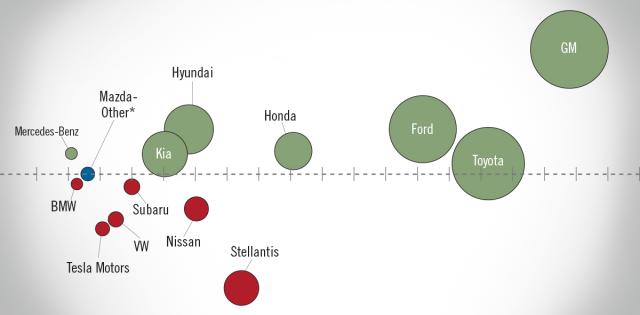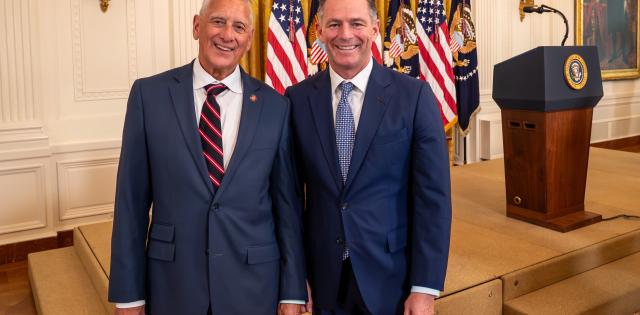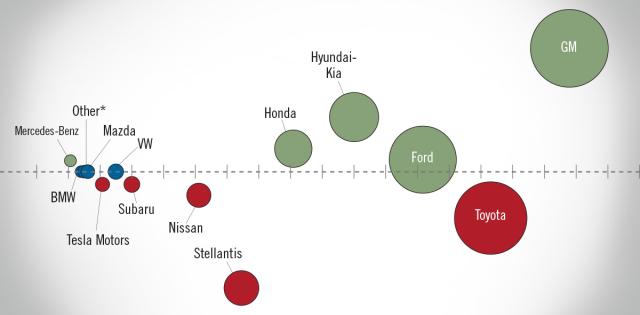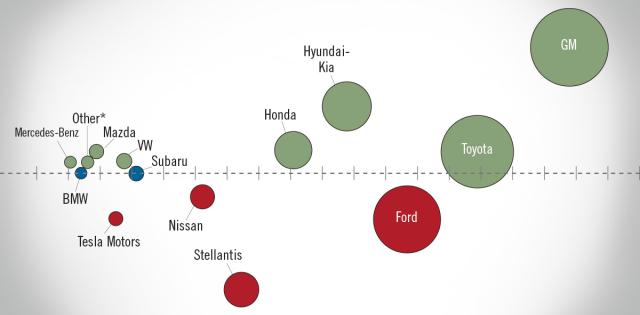Today’s vehicle financing model is extraordinarily efficient and competitive and provides access to affordable credit to consumers in all credit tiers. This competition is fostered by the ability that dealers currently have to “meet or beat” the best offer that consumers can secure from other creditors.
Despite the competitiveness of the market, and the fact that local dealerships routinely discount loans for their customers, the Consumer Financial Protection Bureau (CFPB) issued “guidance” in 2013 that sought to eliminate these dealer discounts. Congress weighed in on the issue in 2015 with a bipartisan bill – passed overwhelmingly in the House – to withdraw the CFPB guidance, and again in 2018 with a resolution that would disapprove of the guidance through the Congressional Review Act.
The article below explains how auto financing works, and details the history of the CFPB’s campaign to eliminate consumer discounts in auto financing.
How Dealer Assisted Financing Works
Most consumers who purchase a new vehicle from a franchised auto dealer will finance that purchase, and consumers generally obtain their financing in one of two ways: Directly through a bank, independent finance company, or credit union (commonly referred to as “direct financing”); or through the dealer in what is called dealer-assisted financing. Dealer-assisted financing is completely optional to the consumer as the consumer is not required to obtain financing from the dealer in order to purchase the vehicle.
Dealer-assisted financing transactions involve the performance of distinct functions by the dealer and the finance source.
The finance source (the bank, independent finance company, or credit union) serves as the source of funds and conducts underwriting to assess the consumer’s creditworthiness. The underwriting consists of the use of highly sophisticated, proprietary systems to analyze risk-based factors related to the consumer’s credit application such as loan-to-value and debt-to-income ratios, verification of employment, and routine entries on the applicant’s credit report (e.g., credit score, number of delinquent accounts, bankruptcy filings, etc.).
The dealer serves as the retail distribution outlet for the financing. The dealer advertises to and establishes relationships with prospective vehicle purchasers, takes their applications for financing, and sends the applications to one or more finance sources to which the dealer assigns credit and lease contracts. The dealer routinely gathers supplemental documentation from the consumer, as required by the finance source, to consummate the transaction. The dealer prepares all of the transactional documents and executes many forms and functions required by federal and state law (e.g., the initial creditor is solely responsible for providing Truth In Lending Act disclosures and Risk-Based Pricing or Credit Score Disclosure Exception Notices). The dealer also must employ and train the persons who perform these functions and must assume all of the retail costs inherent in the delivery of a product to market (e.g., building costs, utilities, computers, telephones, copying machines, and insurance). If dealers did not perform these functions and assume these costs, this burden would fall on the finance source and would affect the rates at which it could offer financing to consumers.
Explanation of the Components of the Rate Offered to the Consumer
The retail rate that is offered to the consumer in dealer-assisted financing transactions (also known as the “annual percentage rate” or “APR”) reflects the separate functions performed by the finance source and the dealer. It consists of a wholesale rate (known as the “buy rate”) that is established by the finance source and a retail margin (known as “dealer participation”) that is established by the dealer in its capacity as the retail distributor of the finance product. The buy rate includes the risk premium, along with the finance source’s costs of funds, loan production and servicing costs, and a return on investment on its costs. The dealer participation consists of the dealer’s loan distribution costs and a return on investment on its costs.
These wholesale and retail elements of the retail rate exist in every automobile finance contract, whether they are divided between two parties (as in the case of dealer-assisted financing) or they are handled by a single party (as in the case of a direct loan from a bank or credit union). The amount charged by the dealer cannot be avoided by seeking financing directly from the dealer’s finance sources; in the absence of the function performed by the dealer, the finance source would be required to erect a retail distribution network for its products that would prevent it from being able to offer, on a sustained basis, financing to consumers at the wholesale buy rate that it provides to the dealer. Nor can the amount charged by dealers be avoided by seeking financing directly from a bank or credit union as each must build its retail distribution costs into its pricing structure. Consequently, it should come as no surprise that dealer-assisted financing, which must compete with these alternative finance sources in an intensely competitive market, is chosen by millions of consumers each year.
Thus, charges that dealers “mark-up” loans in the form of adding costs above an amount that consumers would otherwise have access to at the retail level has no basis in reality or fact. From The Washington Post Fact Checker:
[W]e did become curious about a statistic that [Sen. Elizabeth] Warren has frequently cited — that “auto dealer markups cost consumers $26 billion a year.” She referenced a 2011 report released by the Center for Responsible Lending (CRL), which describes itself as a nonpartisan, nonprofit organization that fights “predatory lending practices”…
[E]ven if the $26 billion number were credible — which it is not — Warren incorrectly characterizes it. She claimed that the study showed “auto dealer markups cost consumers $26 billion a year.” But [CRL Senior Vice President Chris] Kukla acknowledged that this figure includes compensation for dealers who arranged the loans for car buyers.
“We are careful to say that, yes, this included compensation that is likely to be fairly gotten,” he said. “It is fair for dealers to get compensation for the work they do”…
But besides citing a faulty number, Warren misleadingly says it represents “auto dealer markups.” The group that produced the report said that figure includes reasonable compensation owed to car dealers. She earns Four Pinocchios.
The amount of dealer participation typically is determined by negotiation between the dealer and the consumer in much the same way that the dealer’s retail margin is established in a vehicle sale. It is based on factors such as the extent to which the dealer can offer a competitive rate, its desire to sell a particular vehicle, and its efforts to develop and maintain customer loyalty. Dealer participation may not exceed contractual rate caps (which historically are between 200-250 basis points, depending on the length of the loan contract) that finance sources routinely establish in finance source-dealer agreements. However, because of intense rate competition among finance sources, dealer participation usually is well below the 200-250 basis point contractual rate cap amount.
The Benefits of Dealer Assisted Financing
Dealer-assisted financing benefits millions of consumers across the credit spectrum in a number of ways.
One of these benefits is the access that most dealers have to multiple finance sources from which the dealer can seek competitive and affordable financing for consumers. Dealers’ access to captive and independent finance companies, banks, and credit unions frequently results in dealers being able to offer more competitive credit terms to consumers than consumers can secure on their own. Even when dealer-assisted financing is not selected by consumers, its mere presence helps to create an intensely competitive market that significantly disciplines the rates that other finance sources will offer to consumers.
Another critically important benefit is dealers’ enhanced ability to secure financing for the millions of Americans who are unable to obtain it on their own. Many of these “unbanked” consumers are responsible borrowers but elements of their credit profile prevent them, particularly in the current credit environment, from being able to secure financing directly from banks and credit unions. Dealers work in earnest to obtain financing for these consumers and dealers’ access to multiple finance sources (including many that may not be located or advertised in the consumer’s geographic area) strengthens their ability to do so. When dealers are able to secure financing for these consumers, it often is their sole means of securing the transportation they require for their employment and other family and household needs.
And, of course, the dealer’s discretion to take all or part of the dealer participation allows dealers to further discount rates further for their customers. For example, if a customer comes in with a lower rate from a competing finance source, or demonstrates a monthly budget constraint, dealers can cut their own compensation to “buy down” the rate on their customer’s behalf. This rate discounting happens routinely at local dealerships, and is tremendously beneficial for customers because they usually end up with a better rate than they can get on their own. From Bloomberg:
Car dealers sometimes make discounts, at their discretion, on loans they help to arrange with financial companies. That's a pretty fundamental aspect of how they do business. Yet the federal government is trying to put a stop to it.
The CFPB’s Assault on Dealer-Assisted Financing and Consumer Discounts
The Consumer Financial Protection Bureau (CFPB or the Bureau) released guidance on March 21, 2013 without prior notice or an opportunity for public comment, alleging a “significant risk” that dealer-assisted auto financing has a “disparate impact” on the price of credit for consumers in protected classes. This controversial guidance pressures auto finance sources into changing the way they compensate dealers to a flat-fee approach and, in doing so, would eliminate dealer flexibility to offer consumers a discounted interest rate when arranging auto financing.
The CFPB made this “disparate impact” allegation without providing any supporting public analysis or documentation. Careful study of the CFPB guidance, however, reveals that the CFPB’s attempt to regulate auto dealers by pressuring lenders to change their business practices: (1) does not address the disparate impact problem the CFPB alleges; and (2) would raise credit costs and decrease access to credit for consumers. In addition to the harm the CFPB’s directive would cause consumers, the CFPB’s attempt to bring about these fundamental and detrimental changes via “guidance” were an obvious attempt to avoid both the rulemaking process and coordination with the federal agencies that Congress vested with exclusive federal authority over motor vehicle dealers. Congress specifically designed the rulemaking process to ensure that new regulations benefit from public input and scrutiny before they are issued.
Significant Flaws in the CFPB’s Methodology
On November 19, 2014, the prominent research firm Charles River Associates released a peer-review study of CFPB’s methodology, which reviewed more than 8.2 million auto loan records from 2012-2013. The study revealed that CFPB’s analysis was “conceptually flawed and subject to significant bias and estimation error,” and that the CFPB’s findings of variations in interest rates are wildly inflated and fail to consider legitimate factors outside of race and ethnicity that can result in pricing variations.
The study released by Charles River independently demonstrated that CFPB’s statistical model, which the agency used to test for the presence of unintentional discrimination in indirect auto lending, was inherently flawed and completely unreliable. Charles River also demonstrated that CFPB’s application of its test to a lender’s portfolio was similarly flawed and could give the appearance of discrimination where none exists.
The CFPB’s guidance claims that there is a risk of discrimination on the retail/dealer side of auto loans, and on the portfolio/lender side. The Charles River study showed that the CFPB’s method of testing for the presence of discrimination on both sides is fatally flawed. In fact, the review showed that CFPB’s methodology misclassified the background of a significant percentage of loan applicants and dramatically overstated differences in the cost of credit paid by minorities and non-minorities. The study further showed that once legitimate business factors that affect pricing are taken into account, there is no data to support the disparities alleged by the CFPB. From The Wall Street Journal:
A study conducted by Charles River Associates for the American Financial Services Association applied this method to the names in a set of mortgage data (where the race of each borrower is known) and found that the Bayesian method for counting African-Americans was off by 41%.
The consumer bureau’s official position, expressed by Director Richard Cordray at a House Financial Services hearing last month, is that “we disagree with the results” of the Charles River study. But neither Mr. Cordray nor his staff will explain why they disagree with an analysis that appears to demolish the entire basis for their campaign against auto lending.
The CFPB’s guidance was thus terribly uninformed, as it was based on flawed assumptions and lacked adequate peer review. Federal regulators must not carelessly regulate any industry, particularly one with such broad significance to the economy as a whole. As we know, the CFPB did not disclose its testing methodology when it released its guidance, nor did it invite input from affected parties. Public policy should not be made in a process that is uninformed and lacks transparency. The auto finance industry and other members of the public could have corrected the CFPB’s fundamental misunderstanding of the indirect vehicle financing marketplace and flaws in its testing methodology had the CFPB opened up the process earlier.
For example, the CFPB’s lack of transparency has deprived stakeholders of a meaningful opportunity to determine if there are flaws in its initiative. As noted by Sen. Jeanne Shaheen (D-N.H.), in an Oct. 20, 2013, letter to then-CFPB Director Richard Cordray, it is critically important that the CFPB’s efforts in this regard are “done in a fair and transparent way that gives the public an opportunity to weigh in.” As recognized and demanded on several occasions by bipartisan members of the House and Senate, the CFPB needs to identify the complete methodology it employs to measure whether statistically significant disparate impact exists in an auto lender’s portfolio. Otherwise, one can have little confidence that the Bureau’s model is producing reliable results. This requires, among other things, that the Bureau fully account for neutral, legitimate factors that affect dealer compensation which are completely unrelated to a consumer’s background. From The Wall Street Journal:
By the end of this week, the U.S. government will be a step closer to sending out millions of dollars to minority borrowers who were allegedly discriminated against by auto lender Ally Financial Inc.
But there is a potential hitch: No one knows for certain whether all the people getting the checks will actually be minorities…
To find minority borrowers, the U.S. Consumer Financial Protection Bureau and Justice Department opted to essentially make educated guesses using an algorithm that assigns probabilities to whether borrowers are minorities based on their last names and locations.
They have been sending letters in recent months to Ally customers they believe were overcharged based on the results. One version of the letter, sent to borrowers that the CFPB estimates have at least a 95% probability of being minorities, tells recipients that they qualify for a payment and don’t need to do anything more. It asks borrowers to write back if they aren’t minorities.
Another version, sent to borrowers whose likelihood of being a minority under the CFPB algorithm falls between 50% and 95%, asks recipients to sign and return the letter confirming that they are minorities.
It is also essential that the Congress fully consider the assumptions that support the statement in the CFPB Guidance that auto lenders can ensure they are complying with the Equal Credit Opportunity Act (ECOA) by “eliminating dealer discretion” through the adoption of an alternative form of dealer compensation such as the payment of “a flat fee per transaction” or similar approach. This compliance step is flawed in two significant regards.
First, a broad industry move by finance sources to eliminate dealer discretion through the payment of flat fees will, quite simply, fail to eliminate dealer discretion. This is because dealers typically sell credit contracts to a variety of finance sources. Each finance source would set its own flat fee, and dealers would have discretion to select the finance source to which they sell the contract. While this may address the fair lending risk for individual finance sources, it will not address whatever fair lending risk may exist for the consumer.
Second, a broad industry adoption of flat fees would remove the ability of dealers to cut into their own retail margins and win a customer’s business by “meeting or beating” a competitive offer available to the consumer from another financing source. This will weaken competition and, in turn, drive up the cost of credit. This would adversely affect consumers, particularly credit challenged consumers who could lose access to conventional financing for their transportation needs.
These significant flaws in the CFPB’s policy could have been avoided if the Bureau had employed a process that was data- and market-driven and transparent. Nearly all that is known on the record about the Bureau’s disparate impact initiative is what has been derived from congressional oversight.
The Unknown Costs of the CFPB’s Drive to Eliminate Dealer “Meet or Beat” Financing
Section 1022 of the Dodd-Frank Act requires the CFPB to consider, when issuing a rule, the potential benefits and costs (including the potential reduction of consumer access to financial products and services) that could be caused by such a rule. One consequence of its avoiding the rulemaking process is that the CFPB avoids having to conduct, and does not benefit from, a study into the potential impact its new policy would have on consumers. In response to an October 2013 letter sent by 22 Senators, the CFPB acknowledged that it never studied how eliminating a dealer’s ability to discount credit would affect the cost of credit paid by consumers. Reducing a strong competitive force from the vehicle financing marketplace will likely raise the cost of credit for consumers. Moreover, according to Fitch Ratings, the CFPB’s drive to eliminate or severely limit “meet or beat” financing offered by auto dealers “will likely raise lender regulatory costs in 2014.”
Together, the weakening of competition and higher regulatory costs can be expected to result in higher credit costs for consumers. And, most troubling, the CFPB’s actions could disproportionally hurt consumers with less-than-perfect credit since those customers will be less able to afford any higher rates and will therefore have even more limited options to buy a car or truck to meet their work and family needs. From The Wall Street Journal:
A federal regulator’s campaign to fight bias against minorities is changing the way many car loans are priced, a move that is increasing costs for some consumers…
Under Honda’s new pricing plan, borrowers with a relatively high credit score of 760 or above would pay a wholesale rate of at least 3.4% for a new car loan, up from 2.3% before the settlement, according to a pricing sheet distributed by Honda to dealers in Texas and reviewed by The Wall Street Journal. Add in a dealer markup of 0.5 percentage point, for example, and the borrower could end up with an annual percentage rate of 3.9%, compared with 2.8% before. Over the life of a four-year $25,000 loan, that would add $586 in interest payments.
NADA’s Better Approach
Discrimination in any market – including indirect auto financing – has no place in society, and NADA fully supports the efforts of the CFPB and other federal agencies to eliminate it from the marketplace.
Despite the fact that the CFPB’s “disparate impact” allegations are unexplained and unsubstantiated, in January 2014, NADA, in conjunction with the National Association of Minority Automobile Dealers (NAMAD), and the American International Automobile Dealers Association (AIADA) released its Fair Credit Compliance Policy & Program to assist franchised auto dealers in addressing even the possibility of retail level discrimination in dealer-assisted financing. And, unlike the CFPB’s approach, the NADA/NAMAD/AIADA Program not only actually addresses the possibility of disparate impact, it does so in a way that is both pro-consumer and pro-competitive.
It is important to note that the NADA/NAMAD/AIADA Program: 1) is entirely voluntary; 2) has not been formally adopted by any federal agency as a means of complying with the ECOA; and 3) is not a “safe harbor” for those who elect to adopt it. These important caveats aside, the NADA/NAMAD/AIADA Program provides a very valuable resource for franchised auto dealers.
First, it allows dealers to effectively manage the discretion that it exercises by adopting a compliance approach that the Department of Justice (DOJ) Civil Rights Division embraced in 2007 in two consent orders. These orders were entered into with dealers to resolve allegations of unlawful discrimination. While the details of the Program are comprehensive, the basic framework is simple:
- A dealer who adopts the Program establishes a “Standard Dealer Participation Rate” – that is, a standard retail margin – for its dealership;
- In each and every transaction, the dealer adds the Standard Dealer Participation Rate to the bank or finance company wholesale buy rate to establish the retail APR that the dealer offers to all prospective customers; and
- The Standard Dealer Participation Rate, which would generally be a set number of basis points, is the same for every deal and its amount is determined by the individual dealer.
In its 2007 consent orders, the DOJ prudently recognized that stopping there would deprive consumers of the ability to obtain a lower, discounted rate from the dealer when there is a legitimate business reason for the lower rate (i.e., a reason that is unrelated to the customer’s background). In contrast, the CFPB’s Guidance would eliminate a customer’s ability to negotiate a lower interest rate in the showroom. Accordingly, the DOJ, in its consent orders, and NADA/NAMAD/AIADA, in the Program, allow for a downward deviation from the Standard Dealer Participation Rate – but only if one of seven good faith, pro-competitive situations is present. Examples of these pro-competitive situations include where the consumer has access to a more competitive rate from another dealer or lender or where the consumer has a budget constraint. Thus, the NADA/NAMAD/AIADA Program addresses fair credit concerns by promoting a standardized approach that a dealer can adopt to determine its retail margin while preserving sufficient flexibility to allow consumers to benefit from the overwhelming competitive forces that exist in today’s auto financing marketplace.
The NADA/NAMAD/AIADA Program follows other aspects of the DOJ consent orders as well. For example, under the Program the dealer executes a form indicating whether the Standard Dealer Participation Rate or a lower dealer participation rate was included in a credit offer to a consumer. If a lower rate was included, it indicates the allowable reason for deviation that applies. And, the dealer records this determination for every deal.
In addition, as with any sound regulatory compliance program, the NADA/NAMAD/AIADA Program requires a comprehensive set of procedures to effectively carry it out. This includes responsibilities related to training, document review and retention, monitoring, auditing, reporting, coordination, and oversight. In this way, the Program – while completely modeled on the DOJ consent orders – actually contains procedures that are more robust.
While there is no perfect solution to the task of effectively managing discretion, the NADA/NAMAD/AIADA Program can set a dealer on a clear path towards addressing fair credit concerns at the retail level. Accordingly, the Program should be of benefit to all of the parties to an indirect vehicle financing transaction – consumers, dealers, and finance sources alike.
The way to ensure fair lending is straightforward and achievable is the encouragement of a broad industry adoption of the NADA/NAMAD/AIADA Fair Credit Compliance Policy & Program. It is an effective tool that addresses fair credit risks where they matter – at the retail level – in a way that protects consumers, auto dealers, and lenders. It doesn’t require engaging in unreliable, costly, and contentious statistical testing and it avoids meaningless portfolio examinations. By controlling for risk on the front end of the transaction, the problem is solved on the portfolio end as well.
Congress’ Response
Congress on a bipartisan basis began to raise serious concerns with the 2013 guidance shortly after it was issued. Between June 20, 2013, and April 10, 2015, Congress sent 13 separate letters signed by 90 members of both the House and Senate to the CFPB asking for essential information about the accuracy of the analyses upon which the CFPB relied and the methodologies it employed. Not one of these requests was answered fully or satisfactorily.
On April 13, 2015, Rep. Frank Guinta (R-N.H.) and Rep. Ed Perlmutter (D-Colo.) introduced H.R. 1737, the “Reforming CFPB Indirect Auto Financing Guidance Act,” a bill to rescind the CFPB’s flawed auto finance guidance and make the Bureau more transparent and accountable when issuing any such guidance in the future. Before issuing new auto finance guidance, H.R. 1737 would require the CFPB to:
- Provide notice and a period for public comment;
- Make public any studies and analyses upon which the guidance is based;
- Consult with the Federal Reserve Board, Federal Trade Commission and Department of Justice; and
- Study the cost and impact of the guidance on consumers as well as women—owned, minority–owned, and small businesses.
The CFPB took none of these essential steps before issuing its 2013 auto finance guidance. While most guidance is technical and non-controversial, the CFPB’s auto finance guidance is different, as it threatens to: 1) eliminate a dealer’s ability to discount credit in the showroom; 2) raise credits costs; and 3) push marginally creditworthy consumers out of the auto credit market.
H.R. 1737 was a moderate bill that did not dictate a result or tie the CFPB’s hands. The bill merely ensured transparency and public notice so the public would have an opportunity to analyze and comment on the CFPB’s attempt to change the auto loan market. Nor would it have, as its opponents charged, amended or prevented in any way the enforcement – by the CFPB or any other agency – of any fair credit law or regulation, including the Equal Credit Opportunity Act or any of its implementing regulations.
On November 18, 2015, H.R. 1737 passed overwhelmingly in the House by a vote of 332-96, which included the support of 88 Democrats. Despite passing the House with an overwhelmingly bipartisan and veto-proof majority, H.R. 1737 was never taken up in the U.S. Senate.
Congressional Review Act
In December 2017, the Government Accountability Office (GAO) determined that the CFPB’s guidance, which attempted to make a major policy change to the auto lending market without important basic procedural safeguards, is a rule under the Congressional Review Act – confirming a concern raised in Congress as early as 2013. By circumventing the rulemaking process, the agency attempted to avoid transparency, prior notice and public comment, and the provision in the Dodd-Frank Act (Sec. 1029(a)) that explicitly prohibits the CFPB from regulating auto dealers and keeps regulatory oversight of dealers with the Federal Trade Commission and other agencies.
On April 18, the Senate passed S.J.Res. 57 a joint resolution introduced by Sen. Jerry Moran (R-Kan.) to disapprove the CFPB’s 2013 auto finance guidance by a bipartisan vote of 51-47. Rep. Lee Zeldin (R-N.Y.) is the lead sponsor in the House. The House is expected to consider the Senate-passed bill S.J.Res. 57 the week of May 7, 2018.
The goal of S.J.Res. 57 is to affirm Congressional policymaking authority and disapprove the CFPB’s 2013 auto lending guidance that attempts to change the $1.1 trillion-dollar auto loan market.
This resolution in no way amends fair credit laws or hinders their enforcement. Rather, it simply rescinds the CFPB’s 2013 guidance and will not preclude enforcement of the Equal Credit Opportunity Act (ECOA). The resolution is similar to H.R. 1737, the “Reforming CFPB Indirect Auto Financing Guidance Act”, H.R. 1737, which would have rescinded the guidance and passed the House in 2015 by a bipartisan vote of 332-96, including 88 Democrats. The minority views included in the House Financial Services Committee Report accompanying H.R. 1737 [H. Rept. 114-329] stated that “H.R. 1737 does not alter regulated entities’ obligations under the Equal Credit Opportunity Act (ECOA) or the CFPB’s examination or enforcement activity pursuant to ECOA.”
Similarly, S.J.Res. 57 is consistent with ECOA since it does not ban pricing discretion (as noted repeatedly by DOJ) or pricing differentials between groups if they are based on a legitimate business rationale. The DOJ has accepted certain business reasons as legitimate to explain differentials in the amount of dealer participation earned in the financing of automobiles, yet the CFPB refuses to acknowledge these neutral factors or even to provide its rationale for rejecting them.
S.J.Res. 57 would not impact or amend or otherwise affect ECOA, or in any way prohibit, disrupt or affect enforcement of any fair credit laws by the CFPB, or any other agency or affect future agency efforts to enforce fair lending statutes or implementing regulations.
Furthermore, S.J.Res. 57 only rescinds this specific CFPB guidance – it does not affect any other law or regulation. Courts and the Office of Management and Budget alike have contended that guidance documents that purport to have the rule of law and that can be used as the basis for enforcement are to be treated as the functional equivalent of a rulemaking. The precedent under CRA is even clearer, given that it adopts the definition of a “rule” as defined by the Administrative Procedure Act (APA).
The CRA “intentionally adopted the broadest possible definition of the term ‘rule’ when it incorporated the APA’s [the 1946 Administrative Procedure Act] definition,” and was “meant to encompass all substantive rulemaking documents—such as policy statements, guidances, manuals, circulars, memoranda, bulletins, and the like—which as a legal or practical matter an agency wishes to make binding on the affected public.”
Congress using the CRA to attempt to rescind a rule that was not issued as a rule is not new. For example, in 2001, GAO decided that a ‘‘record of decision’’ issued by the Fish and Wildlife Service in connection with a federal irrigation project was a rule under the CRA. In 2008, the GAO ruled that a Bush administration directive regarding the Children’s Health Insurance Program was a rule under the CRA. In response, Sens. Rockefeller (D-WV) and Baucus (D-MT) introduced S.J.Res. 44, bipartisan legislation to rescind this rule which was cosponsored by 49 Senators (including 41 Democrats).
Last year, GAO decided that Interagency Guidance on Leveraged Lending, issued jointly by the Office of the Comptroller of the Currency, Board of Governors of the Federal Reserve System, and Federal Deposit Insurance Corporation, was a rule under the CRA. The GAO’s decision was issued some four years after that guidance was released. The GAO justified its decision by stating it is "[c]lear the CRA covers general statements of policy," and that the leveraged lending notice should have been submitted to Congress for an opportunity to review and disapprove.
On the other hand, not all guidance documents, memorandums, etc. fall under the definition of “rule” under the CRA. In 2003, Rep. Ted Strickland (D-Ohio) asked GAO if a Department of Veterans Affairs memorandum regarding the VA’s marketing activity was a rule. That same year, Rep. Lane Evans (D-Ill.) asked the GAO if a Department of Veterans Affairs memorandum terminating the Vendee Loan Program was a rule. In both cases, GAO decided these memorandums were not “rules” under the CRA. And while passage of S.J.Res. 57 will reinforce the importance of following Congressional intent when regulating, it will not impose a blanket prohibition against regulating in this area.
Still after more than five years of Congress debating this issue, including a 2015 House vote of 332-96 to rescind the flawed auto finance guidance, a House-passed appropriation amendment to withhold funding for guidance enforcement, 13 bicameral, bipartisan congressional letters, and numerous questions at CFPB oversight hearings regarding the consumer impact, passage of S.J.Res. 57 will bring a final resolution on this issue, as a future CFPB director will be barred from reissuing guidance that is substantially the same.
Additionally, enactment of S.J.Res. 57 sends a powerful message to all executive branch agencies that Congress expects an open and public process when issuing rules, and expects the laws it passes to be followed.










